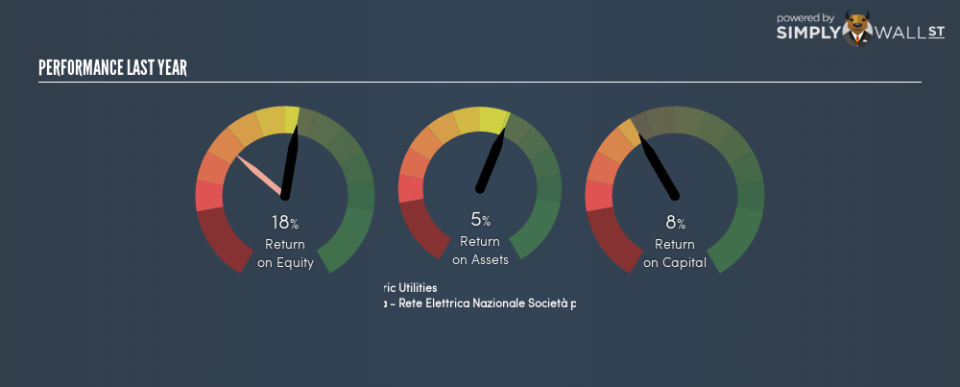Here’s why Terna – Rete Elettrica Nazionale Società per Azioni’s (BIT:TRN) Returns On Capital Matters So Much

Today we’ll look at Terna – Rete Elettrica Nazionale Società per Azioni (BIT:TRN) and reflect on its potential as an investment. Specifically, we’ll consider its Return On Capital Employed (ROCE), since that will give us an insight into how efficiently the business can generate profits from the capital it requires.
Firstly, we’ll go over how we calculate ROCE. Second, we’ll look at its ROCE compared to similar companies. And finally, we’ll look at how its current liabilities are impacting its ROCE.
What is Return On Capital Employed (ROCE)?
ROCE is a metric for evaluating how much pre-tax income (in percentage terms) a company earns on the capital invested in its business. Generally speaking a higher ROCE is better. In brief, it is a useful tool, but it is not without drawbacks. Author Edwin Whiting says to be careful when comparing the ROCE of different businesses, since ‘No two businesses are exactly alike.’
So, How Do We Calculate ROCE?
Analysts use this formula to calculate return on capital employed:
Return on Capital Employed = Earnings Before Interest and Tax (EBIT) ÷ (Total Assets – Current Liabilities)
Or for Terna – Rete Elettrica Nazionale Società per Azioni:
0.084 = €1.1b ÷ (€16b – €2.8b) (Based on the trailing twelve months to September 2018.)
So, Terna – Rete Elettrica Nazionale Società per Azioni has an ROCE of 8.4%.
View our latest analysis for Terna – Rete Elettrica Nazionale Società per Azioni
Want to help shape the future of investing tools and platforms? Take the survey and be part of one of the most advanced studies of stock market investors to date.
Does Terna – Rete Elettrica Nazionale Società per Azioni Have A Good ROCE?
When making comparisons between similar businesses, investors may find ROCE useful. We can see Terna – Rete Elettrica Nazionale Società per Azioni’s ROCE is around the 7.2% average reported by the Electric Utilities industry. Aside from the industry comparison, Terna – Rete Elettrica Nazionale Società per Azioni’s ROCE is mediocre in absolute terms, considering the risk of investing in stocks versus the safety of a bank account. Readers may find more attractive investment prospects elsewhere.
It is important to remember that ROCE shows past performance, and is not necessarily predictive. ROCE can be misleading for companies in cyclical industries, with returns looking impressive during the boom times, but very weak during the busts. ROCE is only a point-in-time measure. Since the future is so important for investors, you should check out our free report on analyst forecasts for Terna – Rete Elettrica Nazionale Società per Azioni.
What Are Current Liabilities, And How Do They Affect Terna – Rete Elettrica Nazionale Società per Azioni’s ROCE?
Liabilities, such as supplier bills and bank overdrafts, are referred to as current liabilities if they need to be paid within 12 months. The ROCE equation subtracts current liabilities from capital employed, so a company with a lot of current liabilities appears to have less capital employed, and a higher ROCE than otherwise. To counteract this, we check if a company has high current liabilities, relative to its total assets.
Terna – Rete Elettrica Nazionale Società per Azioni has total assets of €16b and current liabilities of €2.8b. As a result, its current liabilities are equal to approximately 17% of its total assets. This is a modest level of current liabilities, which would only have a small effect on ROCE.
The Bottom Line On Terna – Rete Elettrica Nazionale Società per Azioni’s ROCE
That said, Terna – Rete Elettrica Nazionale Società per Azioni’s ROCE is mediocre, there may be more attractive investments around. Of course you might be able to find a better stock than Terna – Rete Elettrica Nazionale Società per Azioni. So you may wish to see this free collection of other companies that have grown earnings strongly.
If you like to buy stocks alongside management, then you might just love this free list of companies. (Hint: insiders have been buying them).
To help readers see past the short term volatility of the financial market, we aim to bring you a long-term focused research analysis purely driven by fundamental data. Note that our analysis does not factor in the latest price-sensitive company announcements.
The author is an independent contributor and at the time of publication had no position in the stocks mentioned. For errors that warrant correction please contact the editor at editorial-team@simplywallst.com.

